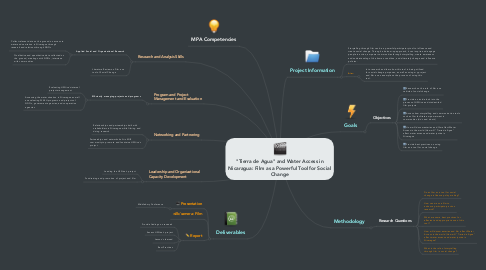
1. Leadership and Organizational Capacity Development
1.1. Leading the H2Nica's project
1.2. Fundraising and promotion of project and film
2. Deliverables
2.1. Presentation
2.1.1. Middlebury Conference
2.2. Film
2.3. Report
2.3.1. Provide findings on research
2.3.2. Assess H2Nica's project
2.3.3. Lesson's learned
2.3.4. Best Practices
3. MPA Competencies
4. Networking and Partnering
4.1. Relationships and partnerships built with stakeholders in Nicaragua while filming and doing research
4.2. Partnerships and networks built in MIIS community to promote and fundraise H2Nica's project
5. Program and Project Management and Evaluation
5.1. Efficiently managing projects and programs
5.1.1. Evaluating H2Nica's internal project management
5.1.2. Assessing the water situation in Nicaragua as well as evaluating WASH programs and projects of NGOs, government agencies, and cooperation agencies
6. Research and Analysis Skills
6.1. Applied Social and Organizational Research
6.1.1. Collect relevant data on the ground on access to water and sanitation in Nicaragua through research and relations through NGOs
6.1.2. Qualitative and quantitative data collected on the ground, meetings with NGOs, interviews with communities
6.2. Literature Review on Film as a tool of Social Change
7. Project Information
7.1. Storytelling through film can be a powerful participatory tool to influence and create social change. Through a bottom-up approach, it can inspire and engage people in action, empower communities through storytelling, create awareness and understanding of the human condition, and ultimately change and influence policies.
7.2. Aim:
7.2.1. Is to research and learn how this tool is being utilized for social change purposes, as well as using my project and film as an example on the process of using this tool.
8. Goals
8.1. Objectives
8.1.1. Research on the role of film as a vehicle of social change
8.1.2. Provide an inside look into the process of H2Nica and student-led film projects
8.1.3. Assess how storytelling and communication tools such as film facilitate empowerment in communities (do's and dont's)
8.1.4. How will documentaries and film affect Water Access in the world (How will "Tierra de Agua" affect water access and water justice in Nicaragua
8.1.5. Provide best practices on using film as a tool for social change
9. Methodology
9.1. Research Questions
9.1.1. Does film as a tool for social change influence policy making?
9.1.2. How can we use film to enhance participatory action research?
9.1.3. What are some best practices for effecient and appropriate use of this tool?
9.1.4. How will documentaries and film affect Water Access in the world (How will "Tierra de Agua" affect water access and water justice in Nicaragua?
9.1.5. What is the role of storytelling through film in social change?
